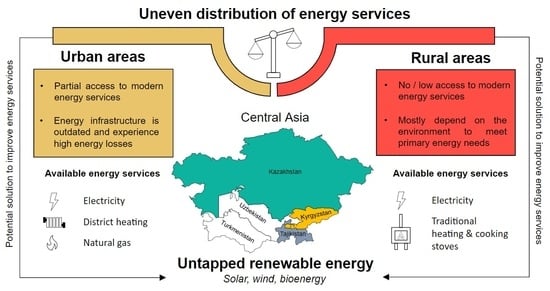The Energy Situation in Central Asia: A Comprehensive Energy Review Focusing on Rural Areas
Abstract
1. Introduction
1.1. Background and Context
1.2. A Framework of Energy Resources
1.3. Objective and Methodology
2. The Central Asian Power Sector
2.1. Kazakh Power Sector
2.2. Kyrgyz Power Sector
2.3. Tajik Power Sector
3. The Central Asian Heating Sector
3.1. Kazakh Heating Sector
3.2. Kyrgyz Heating Sector
3.3. Tajik Heating Sector
4. Hot Water Preparation and Cooking in Central Asia
4.1. Domestic Hot Water
4.2. Cooking Methods and Fuel Sources for Cooking
5. The Potential of Renewable Energy in Central Asia and Current Trend
6. Analytical Discussion and Future Perspectives
- According to the climatic situation of Central Asia, space heating is a necessary energy need for local people. Therefore, most of the energy is consumed for domestic heating as compared to cooking and lighting.
- Because of the Soviet Union’s development in the late 1990s, all Central Asian countries are nearly electrified. However, the transmission lines and the power sector of Kazakhstan, Kyrgyzstan, and Tajikistan are obsolete and facing a similar issue of inter-seasonal demand. This can be immediately linked with the heating sectors of these countries. The provision of the DH network is mainly concentrated in the urban areas, and therefore, the urban households more often use electric heating systems. This increases the burden on the power sector and causes persistent shortages/outages. The low-population remote settlements lose power supply first. Hence, the actual electricity access is neither reliable nor affordable, especially for rural people. Hence, to meet primary energy needs, the rural population intensively use solid fuels.
- Rural settlements in Central Asia experience a high degree of energy scarcity and vulnerability. The majority of the rural population directly depends on the environment and fulfil their basic energy needs with the traditional approach/non-sustainable solid fuels.
- It can be identified from the presented review article that the energy infrastructure of Central Asia plays a critical role in terms of energy access.
- Central Asia is endowed with a great amount of RE resources. However, the renewable sector is not yet exploited because of the limited infrastructure, current energy policies, and a lack of scientific knowledge.
- To enhance the energy supply and services, the untapped RE resources in Central Asia are the most suitable resources for establishing sustainability in rural Central Asia.
7. Conclusions
Author Contributions
Funding
Institutional Review Board Statement
Informed Consent Statement
Data Availability Statement
Acknowledgments
Conflicts of Interest
References
- Rao, P.S.C.; Miller, J.B.; Wang, Y.D.; Byrne, J.B. Energy-microfinance intervention for below poverty line households in India. Energy Policy 2009, 37, 1694–1712. [Google Scholar] [CrossRef]
- Brew-Hammond, A. Energy access in Africa: Challenges ahead. Energy Policy 2010, 38, 2291–2301. [Google Scholar] [CrossRef]
- Angelou, N.; Bhatia, M. Capturing the Multi-Dimensionality of Energy Access (English): Live Wire Knowledge Note Series, Washington. 2014. Available online: http://documents.worldbank.org/curated/en/937711468320944879/Capturing-the-multi-dimensionality-of-energy-access (accessed on 5 April 2020).
- Carrillo, N. Assessment of Household Energy Access: The Progress out of Energy Poverty Index (PEPI) Toolkit for the Microfinance Sector. Ph.D. Thesis, Technical University of Berlin, Berlin, Germany, 2017. [Google Scholar]
- Muhumuza, R.; Zacharopoulos, A.; Mondol, J.D.; Smyth, M.; Pugsley, A. Energy consumption levels and technical approaches for supporting development of alternative energy technologies for rural sectors of developing countries. Renew. Sustain. Energy Rev. 2018, 97, 90–102. [Google Scholar] [CrossRef]
- Monyei, C.G.; Akpeji, K.O. Repurposing Electricity Access Research for the Global South: A Tale of Many Disconnects. Joule 2020, 4, 278–281. [Google Scholar] [CrossRef]
- Hostettler, S.; Gadgil, A.; Hazboun, E. Sustainable Access to Energy in the Global South; Springer International Publishing: Cham, Switzerland, 2015; ISBN 978-3-319-20208-2. [Google Scholar]
- Mainali, B.; Silveira, S. Alternative pathways for providing access to electricity in developing countries. Renew. Energy 2013, 57, 299–310. [Google Scholar] [CrossRef]
- Shadrina, E. Renewable Energy in Central Asian Economies: Role in Reducing Regional Energy Insecurity; ADBI Working Paper 993, Tokyo. 2019. Available online: https://www.adb.org/publications/renewable-energy-central-asian-economies (accessed on 5 April 2020).
- World Bank. Central Asia—Water and Energy Program: Working for Energy and Water Security (English) No. 141508, Washington. 2019. Available online: http://documents.worldbank.org/curated/en/141991567780869624/Central-Asia-Water-and-Energy-Program-Working-for-Energy-and-Water-Security (accessed on 24 October 2020).
- World Bank. Surface Area (sq. km). Available online: https://data.worldbank.org/indicator/AG.SRF.TOTL.K2 (accessed on 24 October 2020).
- World Bank. Population. Available online: https://data.worldbank.org/indicator/sp.pop.totl (accessed on 20 February 2019).
- World Bank. GDP (current US$). Available online: https://data.worldbank.org/indicator/NY.GDP.MKTP.CD (accessed on 30 October 2020).
- World Bank. GNI per Capita, Atlas Method (Current US$). Available online: https://data.worldbank.org/indicator/NY.GNP.PCAP.CD (accessed on 30 October 2020).
- Pohl, B.; Kramer, A.; Hull, W.; Blumstein, S.; Abdullaev, I.; Tais, K.J.R.; Strikeleva, E.; Interwies, E.; Görlitz, S. Rethinking Water in Central Asia: The costs of Inaction and Benefits of Water Cooperation; Swiss Agency of Development and Cooperation (SDC): Berlin, Germany, 2017. [Google Scholar]
- Batsaikhan, U.; Dabrowski, M. Central Asia—twenty-five years after the breakup of the USSR. Russ. J. Econ. 2017, 3, 296–320. [Google Scholar] [CrossRef]
- Dowling, M.; Wignaraja, G. Central Asia after Fifteen Years of Transition: Growth, Regional Cooperation, and Policy Choices, Philippines. 2006. Available online: https://www.adb.org/sites/default/files/publication/28460/wp03-cars.pdf (accessed on 5 April 2020).
- Batsaikhan, U.; Dabrowski, M. Central Asia at 25. Available online: https://www.bruegel.org/2017/05/central-asia-at-25/ (accessed on 24 February 2020).
- Raballand, G.; Kunth, A.; Auty, R. Central Asia’s transport cost burden and its impact on trade. Econ. Syst. 2005, 29, 6–31. [Google Scholar] [CrossRef]
- Linn, J.F.; Blaxall, M. Central Asia Human Development Report 2005: Bringing Down Barriers: Regional Cooperation for Human Development and Human Security; UNDP Regional Bureau for Europe and the Commonwealth of Independent States: Bratislava, Slovakia, 2005; ISBN 92-95042-34-4. [Google Scholar]
- Russell, M. Connectivity in Central Asia: Reconnecting the Silk Road. Available online: https://www.europarl.europa.eu/RegData/etudes/BRIE/2019/637891/EPRS_BRI(2019)637891_EN.pdf (accessed on 5 April 2020).
- Bobojonov, I.; Aw-Hassan, A. Impacts of climate change on farm income security in Central Asia: An integrated modeling approach. Agric. Ecosyst. Environ. 2014, 188, 245–255. [Google Scholar] [CrossRef]
- Hamidov, A.; Helming, K.; Balla, D. Impact of agricultural land use in Central Asia: A review. Agron. Sustain. Dev. 2016, 36, 77. [Google Scholar] [CrossRef]
- USAID. Climate risk profile: Central Asia: Fact Sheet. Available online: https://www.climatelinks.org/sites/default/files/asset/document/2018-April-30_USAID_CadmusCISF_Climate-Risk-Profile-Central-Asia.pdf (accessed on 30 October 2020).
- Asian Development Bank. Central Asia Atlas of Natural Resources; Asian Development Bank: Metro Manila, Philippines, 2014; ISBN 978-971-561-886-1. [Google Scholar]
- Orlovsky, L.; Orlovsky, N.; Durdyev, A. Dust storms in Turkmenistan. J. Arid Environ. 2005, 60, 83–97. [Google Scholar] [CrossRef]
- Indoitu, R.; Orlovsky, L.; Orlovsky, N. Dust storms in Central Asia: Spatial and temporal variations. J. Arid Environ. 2012, 85, 62–70. [Google Scholar] [CrossRef]
- Frenken, K. Irrigation in Central Asia in Figures: AQUASTAT Survey—2012; Food and Agriculture Organization of the United Nations: Rome, Italy, 2013; ISBN 978-92-5-107660-6. [Google Scholar]
- Rahaman, M.M. Principles of Transboundary Water Resources Management and Water-related Agreements in Central Asia: An Analysis. Int. J. Water Resour. Dev. 2012, 28, 475–491. [Google Scholar] [CrossRef]
- Zou, S.; Jilili, A.; Duan, W.; Maeyer, P.D.; Van de Voorde, T. Human and Natural Impacts on the Water Resources in the Syr Darya River Basin, Central Asia. Sustainability 2019, 11, 3084. [Google Scholar] [CrossRef]
- FAO. AQUASTAT Country Profile—Tajikistan, Rome (Italy). 2012. Available online: http://www.fao.org/3/ca0369en/CA0369EN.pdf (accessed on 5 April 2020).
- Mueller, L.; Saparov, A.; Lischeid, G. (Eds.) Novel Measurement and Assessment Tools for Monitoring and Management of Land and Water Resources in Agricultural Landscapes of Central Asia; Springer: Cham, Switzerland, 2014; ISBN 978-3-319-01016-8. [Google Scholar]
- Aminjonov, F. Re-Thinking Central Asian Energy Security: Pitfalls of Export Diversification Policies, Kazakhstan. 2016. Available online: http://library.fes.de/pdf-files/bueros/kasachstan/13546.pdf (accessed on 16 December 2019).
- IEA. Total Primary Energy Supply (TPES) in Central Asia. Available online: https://www.iea.org/data-and-statistics?country=WORLD&fuel=Energy%20supply&indicator=Total%20primary%20energy%20supply%20(TPES)%20by%20source (accessed on 5 April 2020).
- Christmann, S.; Aw-Hassan, A. Should agricultural research in Central Asia and Caucasus (CAC) re-prioritize its agenda with view to climate change? Agric. Ecosyst. Environ. 2011, 140, 314–316. [Google Scholar] [CrossRef]
- Qi, J.; Bobushev, T.S.; Kulmatov, R.; Groisman, P.; Gutman, G. Addressing global change challenges for Central Asian socio-ecosystems. Front. Earth Sci. 2012, 6, 115–121. [Google Scholar] [CrossRef]
- Ariza, C.; Maselli, D.; Kohler, T. Mountains: Our Life, Our Future. Progress and Perspectives on Sustainable Mountain Development from Rio 1992 to Rio 2012 and Beyond; Centre for Development and Environment, University of Bern: Bern, Switzerland, 2013. [Google Scholar]
- Xenarios, S.; Gafurov, A.; Schmidt-Vogt, D.; Sehring, J.; Manandhar, S.; Hergarten, C.; Shigaeva, J.; Foggin, M. Climate change and adaptation of mountain societies in Central Asia: Uncertainties, knowledge gaps, and data constraints. Reg. Environ. Change 2019, 19, 1339–1352. [Google Scholar] [CrossRef]
- Reyer, C.P.; Otto, I.M.; Adams, S.; Albrecht, T.; Baarsch, F.; Cartsburg, M.; Coumou, D.; Eden, A.; Ludi, E.; Marcus, R.; et al. Climate change impacts in Central Asia and their implications for development. Reg. Environ. Change 2017, 17, 1639–1650. [Google Scholar] [CrossRef]
- Kampakis, A. Divesting from fossil fuels in Central Asia: Factors affecting Renewable Energy Transition in Kazakhstan, Kyrgyzstan, Tajikistan. Master Thesis, Vrije Universiteit, Amsterdam, The Netherland, 2015. [Google Scholar]
- Abbasi, Z.A.K.; Nawaz, A. Impact of Climate Change Awareness on Climate Change Adaptions and Climate Change Adaptation Issues. PJAR 2020, 36. [Google Scholar] [CrossRef]
- Zhang, M.; Chen, Y.; Shen, Y.; Li, B. Tracking climate change in Central Asia through temperature and precipitation extremes. J. Geogr. Sci. 2019, 29, 3–28. [Google Scholar] [CrossRef]
- Qi, J.; Kulmatov, R. An Overview of Environmental Issues In Central Asia. In Environmental Problems of Central Asia and their Economic, Social and Security Impacts; Qi, J., Evered, K.T., Eds.; Springer Netherlands: Dordrecht, The Netherlands, 2008; pp. 3–14. ISBN 978-1-4020-8959-6. [Google Scholar]
- Junxia, L. Investments in the energy sector of Central Asia: Corruption risk and policy implications. Energy Policy 2019, 133, 110912. [Google Scholar] [CrossRef]
- Chen, H.; Liu, H.; Chen, X.; Qiao, Y. Analysis on impacts of hydro-climatic changes and human activities on available water changes in Central Asia. Sci. Total Environ. 2020, 737, 139779. [Google Scholar] [CrossRef]
- World Bank. Access to Electricity (% of Population). Available online: https://data.worldbank.org/indicator/EG.ELC.ACCS.ZS (accessed on 5 March 2021).
- Toralieva, G. Destruction of Central Asian Electricity Grid: Causes and Implications. Available online: https://www.ceps.eu/ceps-publications/destruction-central-asian-electricity-grid-causes-and-implications/ (accessed on 5 April 2020).
- GICA. Central Asian Power System (CAPS). Available online: https://www.gica.global/initiative/central-asian-power-system-caps (accessed on 23 September 2020).
- Asia Pacific Energy Portal. Energy and Development in Central Asia: A Statistical Overview of Energy Sectors in Kazakhstan, Kyrgyzstan, Tajikistan, Turkmenistan, and Uzbekistan. Available online: https://www.unescap.org/sites/default/files/Central%20Asia%20Statistical%20Perspective%202018_WEB.pdf (accessed on 10 April 2020).
- World Bank. Central Asia Energy-Water Development Program: Annual Report 2017; No. 132036, Washington D.C., 2018. Available online: http://documents.worldbank.org/curated/en/994621542395781844/Central-Asia-Energy-Water-Development-Program-Annual-Report-2017 (accessed on 10 April 2020).
- IEA. Electricity Generation by Source. Available online: https://www.iea.org/data-and-statistics?country=TAJIKISTAN&fuel=Energy%20supply&indicator=Electricity%20generation%20by%20source (accessed on 10 February 2020).
- Karatayev, M.; Clarke, M.L. Current Energy Resources in Kazakhstan and the Future Potential of Renewables: A Review. Energy Procedia 2014, 59, 97–104. [Google Scholar] [CrossRef]
- Ziesing, H. Scenarios of power demand and supply for Kazakhstan—A view from outside. In Energy Safety: Global and National Aspects; Climate Change Coordination Centre and Nurdana Foundation: Astana, Kazakhstan, 2008. [Google Scholar]
- Ketova, O. Best Practices in Sustainable Energy in Kazakhstan. 2018. Available online: https://www.unece.org/fileadmin/DAM/project-monitoring/unda/16_17X/A2.1_Implement_Natl_CS/Kazakhstan_EnergySectorReport.pdf (accessed on 10 April 2020).
- Kadrzhanova, A. Kazakhstan: Power Generation and Distribution Industry. 2013. Available online: http://www.iberglobal.com/files/kazajstan_power.pdf (accessed on 10 April 2020).
- NSC. Kyrgyzstan: Brief statistical handbook: Annual publication; Bishkek (Kyrgyzstan). 2018. Available online: http://www.stat.kg/media/publicationarchive/16db2910-6b8d-48f9-80b9-45b7ac3347bd.pdf (accessed on 22 October 2019).
- PWC. Study for a Power Sector Financing Road Map within Central Asia Regional Economic Cooperation: Kyrgyz Republic, Mobilizing Financing for Priority Projects. 2016. Available online: https://www.carecprogram.org/uploads/CAREC_TA8727_CountryReport_KyrgyzRepublic.pdf (accessed on 15 January 2019).
- Gassner, K.B.; Rosenthal, N.; Hankinson, D.J. Analysis of the Kyrgyz Republic’s Energy Sector: Final Report. World Bank Energy and Extractives Global Practice ECA Region. 2017. Available online: https://openknowledge.worldbank.org/handle/10986/29045 (accessed on 20 September 2018).
- IEC. In-Depth Review of the Energy Efficiency Policy of the Kyrgyz Republic: Energy Charter Protocol on Energy Efficiency and Related Environmental Aspects. Brussels (Belgiumt). 2018. Available online: https://energycharter.org/fileadmin/DocumentsMedia/IDEER/IDEER-KyrgyzstanEN2018.pdf (accessed on 21 December 2019).
- World Bank. Electric Power Transmission and Distribution Losses (% of Output). Available online: https://data.worldbank.org/indicator/EG.ELC.LOSS.ZS?locations=KG (accessed on 13 February 2019).
- FAO. National Gender Profile of Agricultural and Rural Livelihoods—Kyrgyz Republic: Country Gender Assessment Series. Ankara (Turkey). 2016. Available online: http://www.fao.org/3/a-i5763e.pdf (accessed on 20 August 2018).
- World Bank. Heating Assessment for the Urban Building Sector of the Kyrgyz Republic, Bishkek, Kyrgyz Republic. 2015. Available online: https://www.worldbank.org/content/dam/Worldbank/Feature%20Story/ECA/Central%20Asia/KG-Urban-Heating-Study-Summary-en.pdf (accessed on 27 March 2021).
- World Bank. Keeping Warm: Urban Heating Options in the Kyrgyz Republic: Summary Report (English), Washington, DC. 2015. Available online: http://documents.worldbank.org/curated/en/555021468011161504/pdf/97409-WP-P133058-Box391503B-PUBLIC-Heating-Assessment-for-Kyrgyz-P133058-Final.pdf (accessed on 27 November 2018).
- Nabiyeva, K. Renewable Energy and Energy Efficiency in Central Asia: Prospects for German Engagement; Michael Succow Foundation: Greifswald, Germany, 2015. [Google Scholar]
- World Bank. Tajikistan’s Winter Energy Crisis: Electricity Supply and Demand Alternatives; World Bank: Washington, DC, USA, 2012. [Google Scholar]
- Swinkels, R. Assessment of Household Energy Deprivation in Tajikistan: Policy Options for Socially Responsible Reform in the Energy Sector; Washington DC. 2014. Available online: http://documents.worldbank.org/curated/en/137401468303580524/Assessment-of-household-energy-deprivation-in-Tajikistan-policy-options-for-socially-responsible-reform-in-the-energy-sector (accessed on 28 February 2021).
- IEA. Electricity Imports vs. Exports. Available online: https://www.iea.org/data-and-statistics?country=KYRGYZSTAN&fuel=Imports%2Fexports&indicator=ElecImportsExports (accessed on 21 October 2020).
- World Bank. The Costs of Irrigation Inefficiency in Tajikistan; World Bank: Washington, DC, USA, 2017. [Google Scholar]
- Fields, D.; Kochnakyan, A.; Stuggins, G.; Besant-Jones, J. Tajikistan’s Winter Energy Crisis; The World Bank: Washington, DC, USA, 2013; ISBN 978-0-8213-9967-5. [Google Scholar]
- Gerlitz, L.; Steirou, E.; Schneider, C.; Moron, V.; Vorogushyn, S.; Merz, B. Variability of the Cold Season Climate in Central Asia. Part I: Weather Types and Their Tropical and Extratropical Drivers. J. Climate 2018, 31, 7185–7207. [Google Scholar] [CrossRef]
- Kerimray, A.; de Miglio, R.; Rojas-Solórzano, L.; Gallachóir, B.Ó. Household Energy Consumption and Energy Poverty in Kazakhstan; International Association for Energy Economics: 2017. Available online: https://www.iaee.org/en/publications/newsletterdl.aspx?id=382 (accessed on 4 October 2020).
- Meteotest AG. Meteonorm; Meteotest AG: Bern, Switzerland, 2018. [Google Scholar]
- IEA. Total Final Energy Consumption by Sectors in Central Asia. Available online: https://www.iea.org/data-and-statistics?country=TAJIKISTAN&fuel=Energy%20consumption&indicator=Total%20final%20consumption%20(TFC)%20by%20sector (accessed on 5 April 2020).
- Fodde, E. Traditional Earthen Building Techniques in Central Asia. Int. J. Archit. Herit. 2009, 3, 145–168. [Google Scholar] [CrossRef]
- Howie, P.; Atakhanova, Z. Household Coal Demand in Rural Kazakhstan: Subsidies, Efficiency, and Alternatives. Energy Policy Res. 2017, 4, 55–64. [Google Scholar] [CrossRef]
- World Bank. Fueling Kyrgyzstan’s Transition to Clean Household Heating Solutions; World Bank: Washington, DC, USA, 2020. [Google Scholar]
- Kerimray, A.; de Miglio, R.; Rojas-Solórzano, L.; Gallachóir, B.Ó. Incidence of District Heating and Natural Gas Networks on Energy Poverty across Kazakhstan. In Proceedings of the 1st IAEE Eurasian Conference; Energy Economics Emerging from the Caspian Region: Challenges and Opportunities; Baku, Azerbaijan, 28–31 August 2016, 2016. [Google Scholar]
- Kenessariyev, U.; Golub, A.; Brody, M.; Dosmukhametov, A.; Amrin, M.; Erzhanova, A.; Kenessary, D. Human Health Cost of Air Pollution in Kazakhstan. JEP 2013, 4, 869–876. [Google Scholar] [CrossRef]
- Hall, K. Mountain Societies Research Institute About MSRI Resources Partnerships MSRI Publications CAARF Briefs Staff Publications Knowledge Hub Institute of Public Policy and Administration about IPPA IPPA Publications Policy Briefs External Staff Publications Civil Society Initiative Publications Cultural Heritage and Humanities Unit Cultural Heritage Book Series Research Papers Supporting Energy Efficiency and Renewables Uptake in Rural Communities in Mountainous Kyrgyzstan. Available online: https://www.ucentralasia.org/Research/Item/1711/EN (accessed on 5 January 2021).
- World Bank and Factfish. Kyrgyzstan: Forest Area (sq. km). Available online: http://www.factfish.com/statistic-country/kyrgyzstan/forest%20area (accessed on 17 September 2018).
- World Bank and Factfish. Kyrgyzstan: CO2 emissions from solid fuel consumption (kt). Available online: http://www.factfish.com/statistic-country/kyrgyzstan/co2%20emissions%20from%20solid%20fuel%20consumption (accessed on 17 September 2018).
- Lauermann, M.; Betz, F.; Mehta, K.; Thevs, N.; Ehrenwirth, M.; Zörner, W.; Cyffka, B. Preservation of Selected Ecosystem Services in the Floodplains of the Naryn River (Kyrgyzstan): Introducing the ÖkoFlussPlan Project. In Geographica Augustana; Institut für Geographie, Universität Augsburg: Heidelberg, Germany, 2020; pp. 47–53. ISBN 1862-8680. [Google Scholar]
- Balabanyan, A.; Hofer, K.; Finn, J.; Hankinson, D. Keeping Warm: Urban Heating Options in Tajikistan: Summary Report. 2015. Available online: http://documents.worldbank.org/curated/en/353391467986295623/Keeping-warm-urban-heating-options-in-Tajikistan-summary-report (accessed on 25 January 2021).
- Laldjebaev, M. Energy Security, Poverty and Sovereignty in Mountain Communities of Tajikistan. Ph.D. Thesis, Cornell University, New York, NY, USA, 2017. [Google Scholar]
- World Bank. GDP Per Capita (Current US$). Available online: https://data.worldbank.org/indicator/NY.GDP.PCAP.CD?end=2017&start=1960 (accessed on 17 October 2020).
- OWID. Death Rates from Indoor Air Pollution. Available online: https://ourworldindata.org/grapher/death-rate-by-source-from-indoor-air-pollution?time=2017 (accessed on 17 October 2020).
- Jacobsen, R. Energy Efficient Building Methods for Tajikistan; Norges Naturvernforbund: Grensen, Norway, 2009. [Google Scholar]
- Mislimshoeva, B.; Hable, R.; Fezakov, M.; Samimi, C.; Abdulnazarov, A.; Koellner, T. Factors Influencing Households’ Firewood Consumption in the Western Pamirs, Tajikistan. Mt. Res. Dev. 2014, 34, 147–156. [Google Scholar] [CrossRef]
- Bekturganov, Z.; Tussupova, K.; Berndtsson, R.; Sharapatova, N.; Aryngazin, K.; Zhanasova, M. Water Related Health Problems in Central Asia—A Review. Water 2016, 8, 219. [Google Scholar] [CrossRef]
- Russell, M. Water in Central Asia: An Increasingly Scarce Resource. Available online: https://www.europarl.europa.eu/RegData/etudes/BRIE/2018/625181/EPRS_BRI(2018)625181_EN.pdf (accessed on 4 October 2020).
- Kerimray, A.; de Miglio, R.; Rojas-Solórzano, L.; Ó Gallachóir, B.P. Causes of energy poverty in a cold and resource-rich country: Evidence from Kazakhstan. Local Environ. 2018, 23, 178–197. [Google Scholar] [CrossRef]
- FAO. National gender profile of agricultural and rural livelihoods—Tajikistan: Country gender assessment series. Available online: http://www.fao.org/3/a-i5766e.pdf (accessed on 4 October 2020).
- Shadrina, E. Non-Hydropower Renewable Energy in Central Asia: Assessment of Deployment Status and Analysis of Underlying Factors. Energies 2020, 13, 2963. [Google Scholar] [CrossRef]
- Abylkasymova, A.; Eshchanov, B.; Overland, I.; Moldokanov, D.; Aminjonov, F.; Vakulchuk, R. Hydropower Potential of the Central Asian Countries; Central Asia Data-Gathering and Analysis Team. 2019. Available online: https://www.researchgate.net/publication/331716216_Hydropower_Potential_of_the_Central_Asian_Countries (accessed on 4 October 2020).
- Petrov, G. Resources and Use of Renewable Energy in Tajikistan; 2010. Available online: https://www.researchgate.net/publication/336796453_Resources_and_use_of_renewable_energy_in_Tajikistan_2010g?chanel=doi&linkId=5db264f64585155e27ff1208&showFulltext=true (accessed on 4 March 2021).
- Nurdavletova, S.; Akatayeva, A. The renewable energy in the regional development of Central Asia. SSI 2018, 162–185. [Google Scholar] [CrossRef][Green Version]
- Eshchanov, B.R.; Grinwis Plaat Stultjes, M.; Eshchanov, R.A.; Salaev, S.K. Prospects of renewable energy penetration in Uzbekistan—Perception of the Khorezmian people. Renewable and Sustainable Energy Reviews 2013, 21, 789–797. [Google Scholar] [CrossRef]
- Karimov, K.S.; Akhmedov, K.M.; Abid, M.; Petrov, G.N. Effective management of combined renewable energy resources in Tajikistan. Sci. Total Environ. 2013, 461-462, 835–838. [Google Scholar] [CrossRef] [PubMed]
- Baybagyshov, E.; Degembaeva, N. Analysis of usage of the renewable energy in Kyrgyzstan. IOP Conf. Ser. Earth Environ. Sci. 2019, 249, 12021. [Google Scholar] [CrossRef]
- IEA. Uzbekistan Energy Profile. Available online: https://www.iea.org/reports/uzbekistan-energy-profile (accessed on 29 April 2021).
- Yoshino, N.; Taghizadeh-Hesary, F.; Youngho, C.; Le, T.-H. (Eds.) Energy Insecurity in Asia: Challenges, Solutions and Renewable Energy; Asian Development Bank Institute: Tokyo, Japan, 2020; ISBN 978-4-89974-111-4. [Google Scholar]
- IRENA. Trends in Renewable Energy: Installed Capacity. Available online: https://public.tableau.com/views/IRENARETimeSeries/Charts?:embed=y&:showVizHome=no&publish=yes&:toolbar=no (accessed on 29 April 2021).
- Abylkasymova, A.; Moldokanov, D.; Eshchanov, B.; Overland, I.; Aminjonov, F.; Vakulchuk, R. Wind Power Potential of the Central Asian Countries. Available online: http://www.osce-academy.net/upload/file/Wind_Potential_CADGAT_Report17.pdf (accessed on 29 April 2021).
- Gubaidullina, M.; Balaubaeva, B.; Karimova, S. Renewable energy and the regional prospect on sustainable development of Central Asia. IRILY 2017, 80, 4–17. [Google Scholar] [CrossRef]
- Kiseleva, S.V.; Popel’, O.S.; Tarasenko, A.B.; Avezov, R.R. Efficiency estimation for the grid-tie photovoltaic stations construction in some regions of Central Asia and Transcaucasia. Appl. Sol. Energy 2017, 53, 306–311. [Google Scholar] [CrossRef]
- Zavadskiy, V.; Revalde, G. Problems of development of renewable energy facilities in rural regions on example of Kazakhstan. In 19th International Scientific Conference Engineering for Rural Development Proceedings; Latvia University of Life Sciences and Technologies, Faculty of Engineering: Jelgava, Latvia, 2020. [Google Scholar]
- Vakhguelt, A. Renewable Energy Potential of Kazakhstan. DDF 2017, 379, 189–194. [Google Scholar] [CrossRef]
- Karatayev, M.; Hall, S.; Kalyuzhnova, Y.; Clarke, M.L. Renewable energy technology uptake in Kazakhstan: Policy drivers and barriers in a transitional economy. Renew. Sustain. Energy Rev. 2016, 66, 120–136. [Google Scholar] [CrossRef]
- Abidov, A.; Ryspaev, T.; Satybaldyev, A.; Gorbacheva, A. Comparative Analysis of Some Types of Renewable Energy Sources. Industrija 2020, 46, 93–111. [Google Scholar]
- Schulz, D.; Ahrorova, A.D.; Halimjanova, M.K.; Kholov, K.H. The energy supply for mountain settlements in Tajikistan based on renewable energy sources. In Energy Production and Management in the 21st Century; ENERGY QUEST 2014, Ekateringburg, Russia, 23–25 Apr. 2014; Brebbia, C.A., Magaril, E.R., Khodorovsky, M.Y., Eds.; WIT Press: Southampton, UK, 2014; pp. 971–978. [Google Scholar]
- Doukas, H.; Marinakis, V.; Karakosta, C.; Psarras, J. Promoting renewables in the energy sector of Tajikistan. Renew. Energy 2012, 39, 411–418. [Google Scholar] [CrossRef]
- Mehta, K.; Ehrenwirth, M.; Trinkl, C.; Zörner, W.; Greenough, R. A Parametric Study on the Feasibility of Solar-thermal Space Heating and Hot Water Preparation under Cold Climates in Central Asian Rural Areas. In Proceedings of the 13th International Conference on Solar Energy for Buildings and Industry, EuroSun 2020, Virtual, 1–3 September 2020. [Google Scholar]
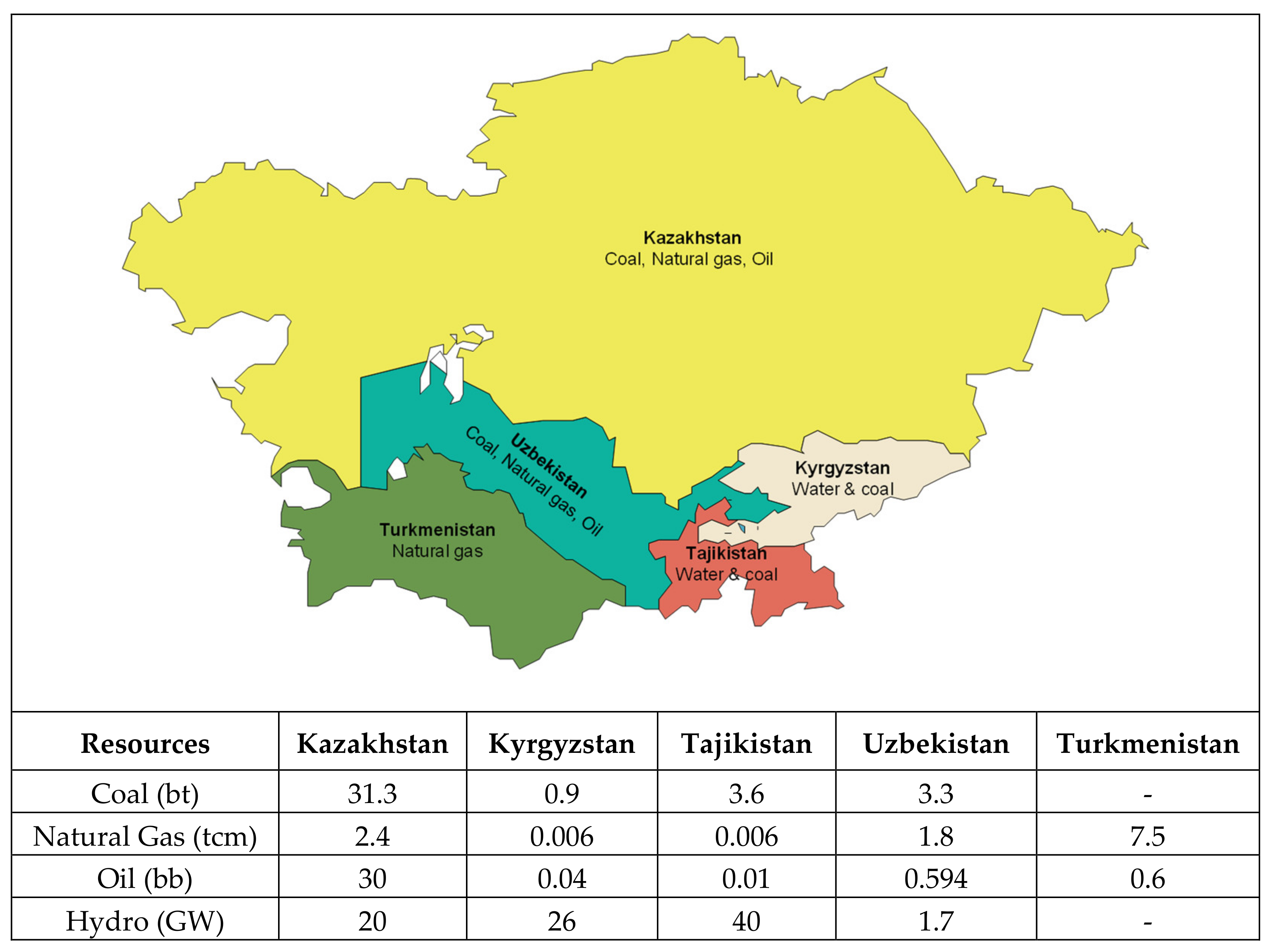
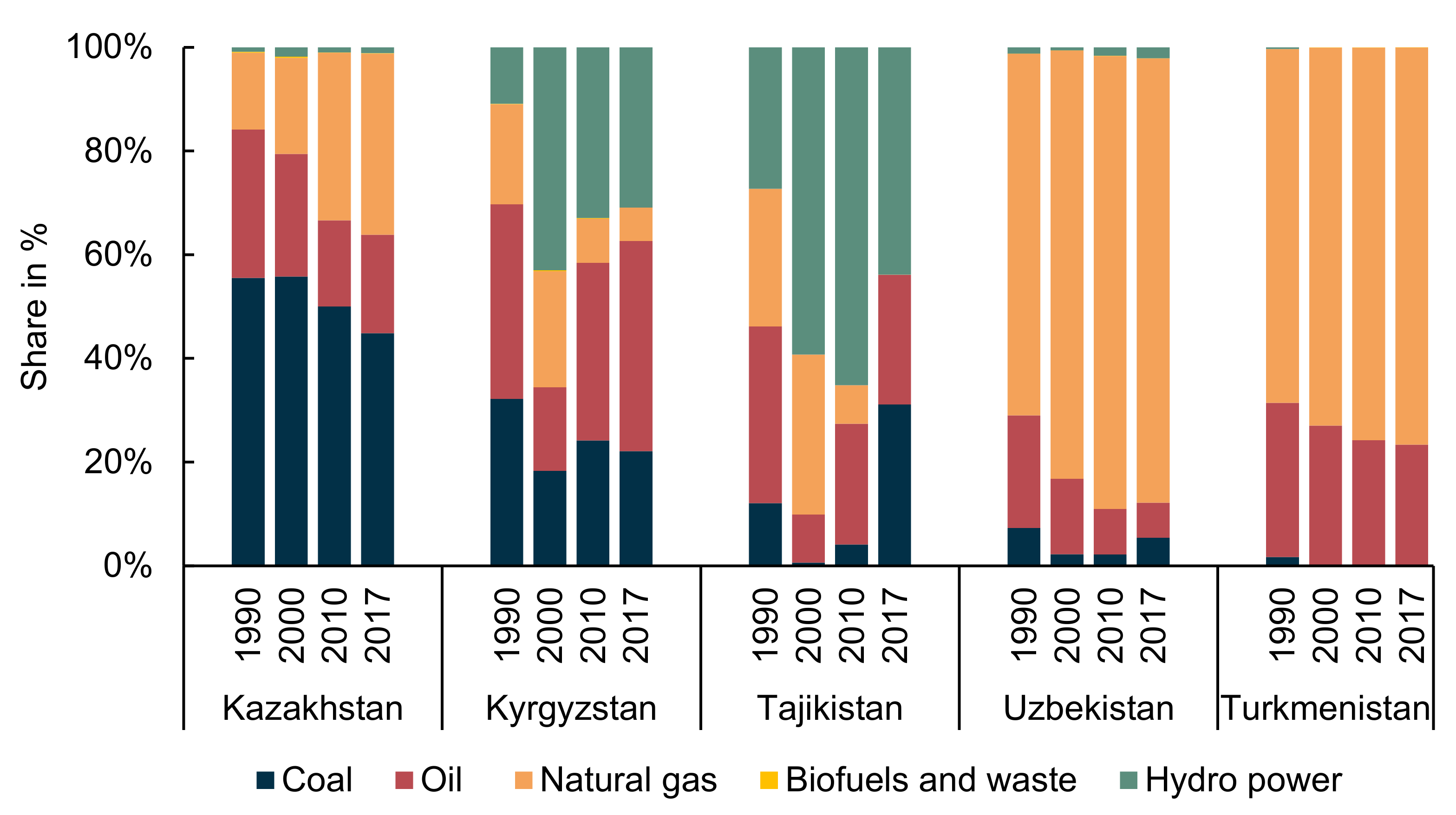
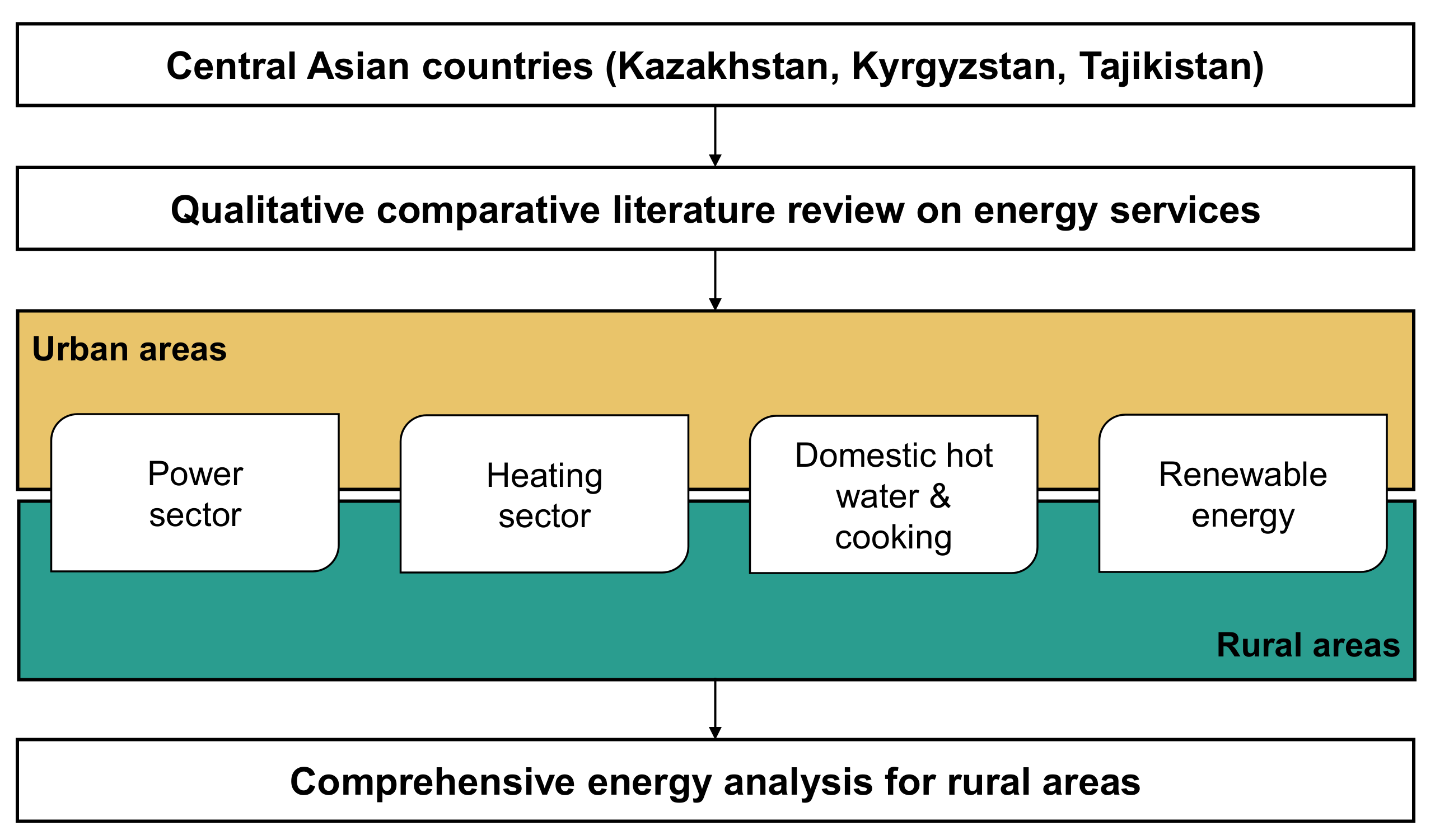
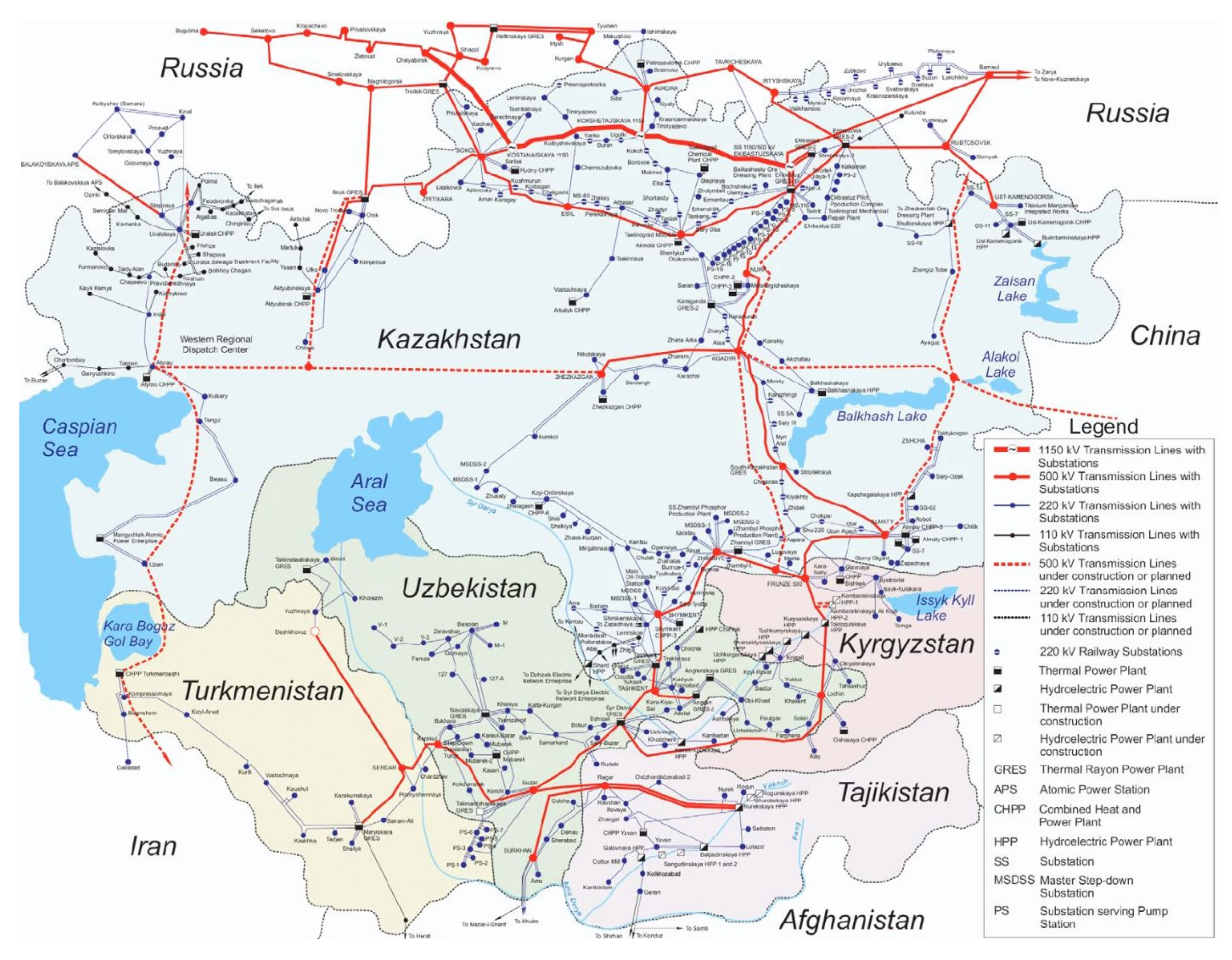
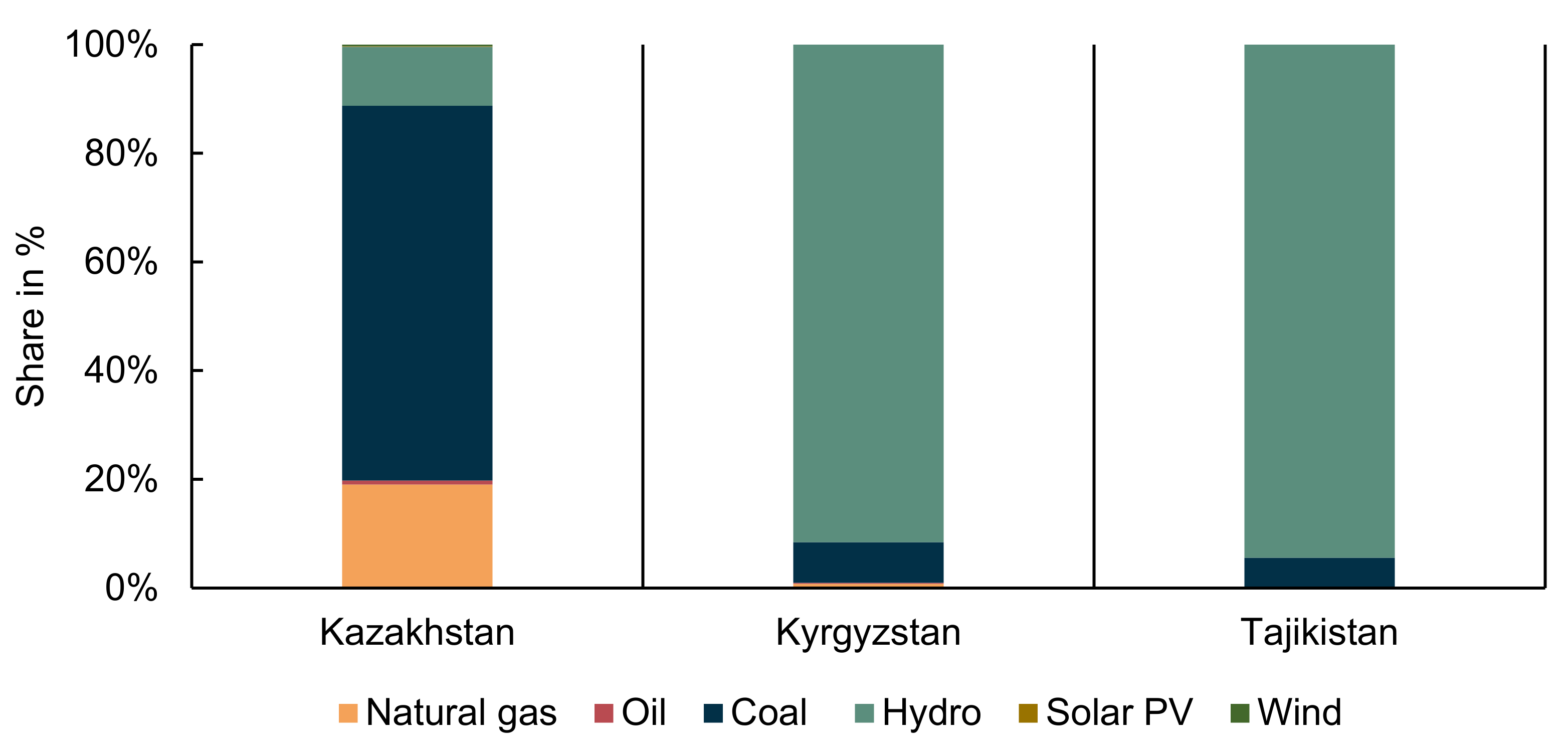

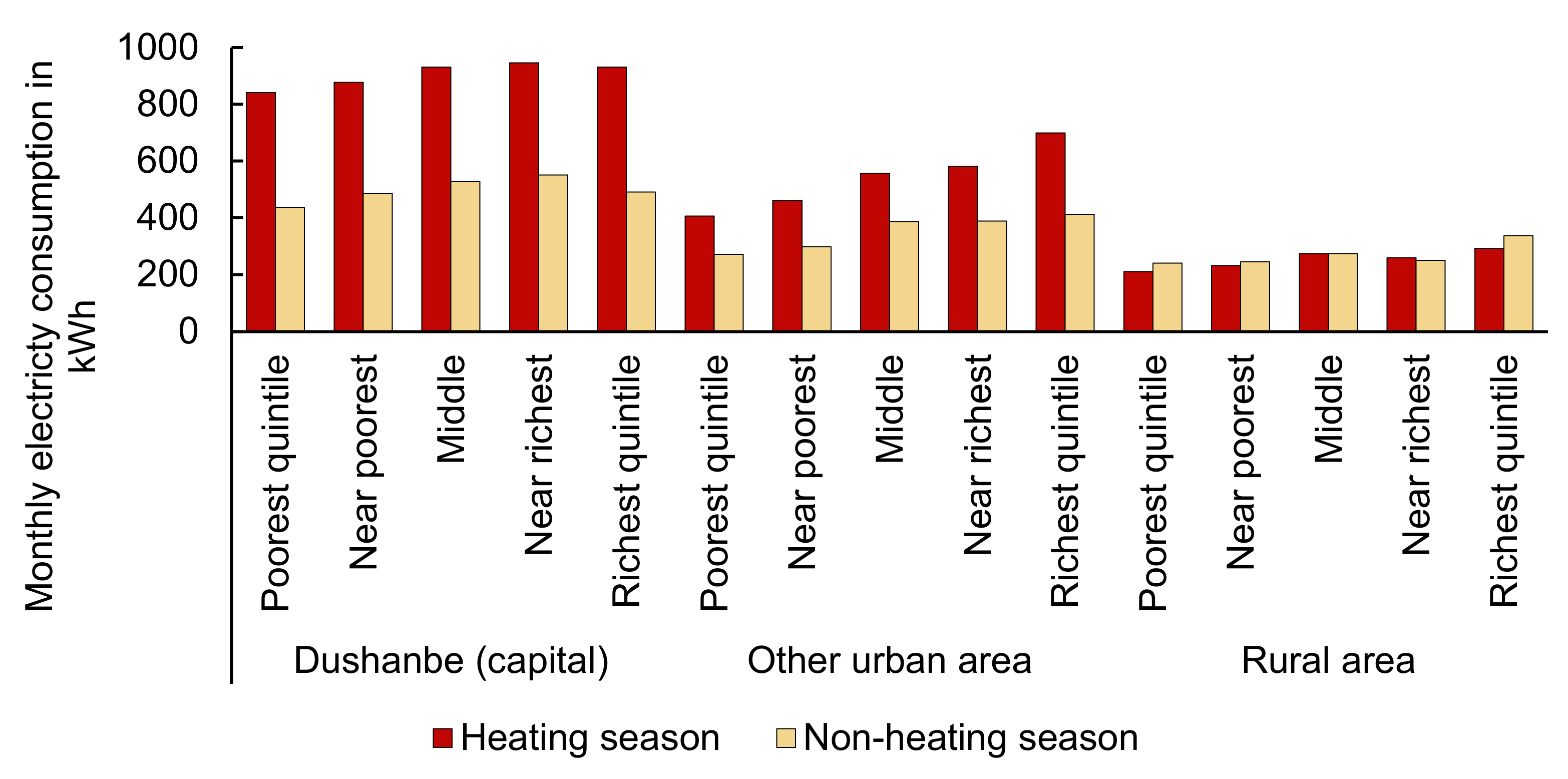
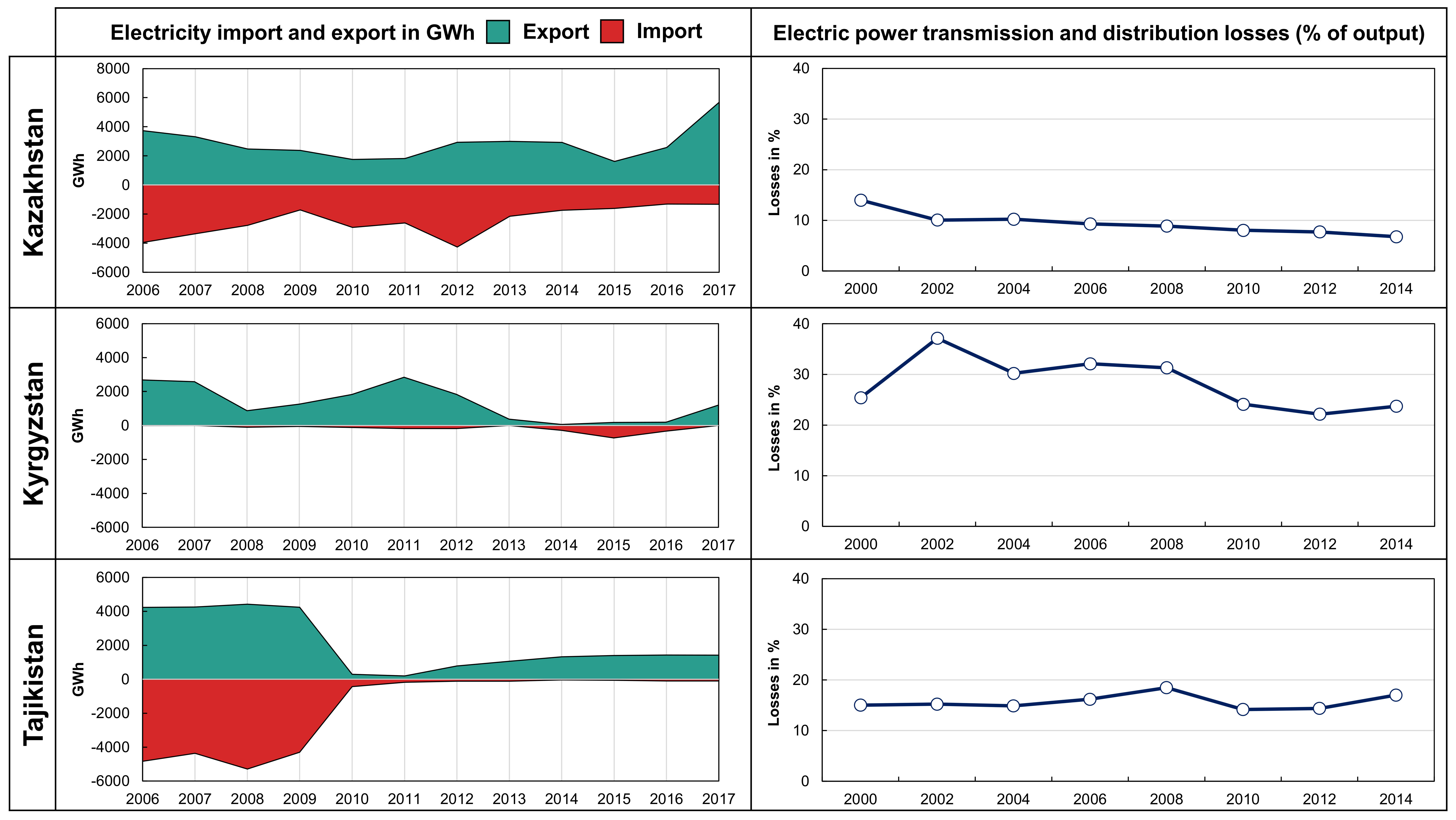
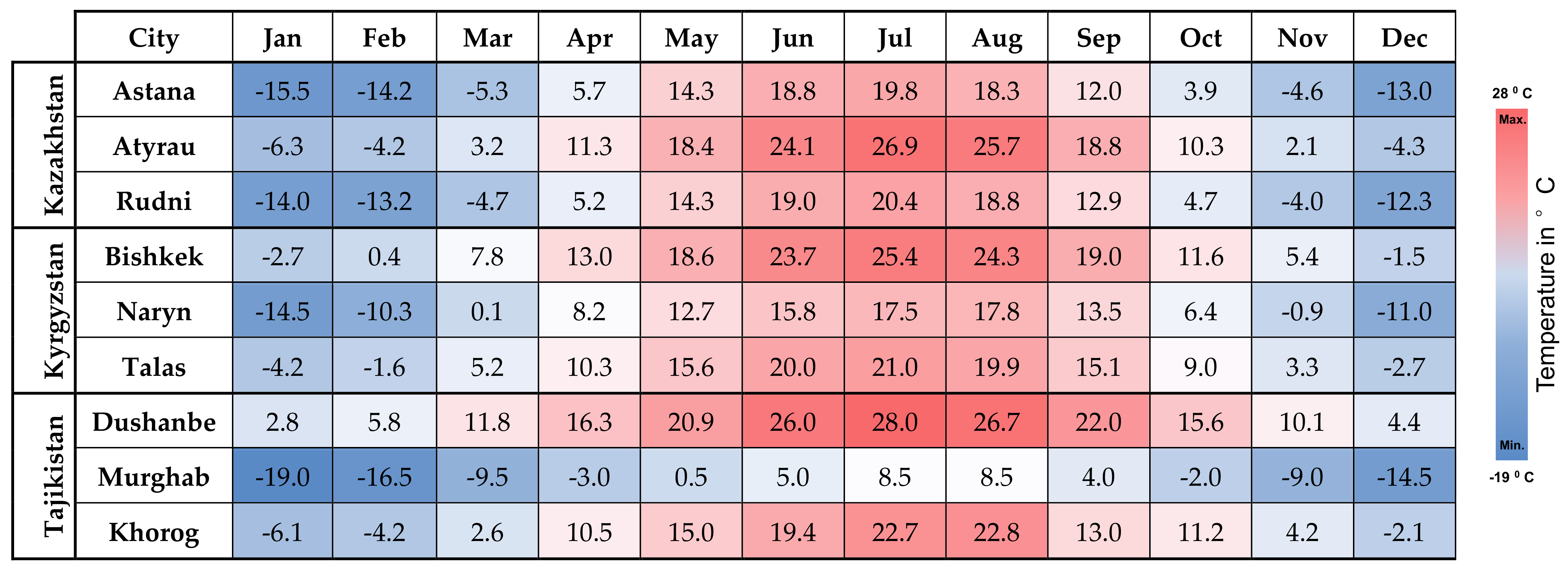

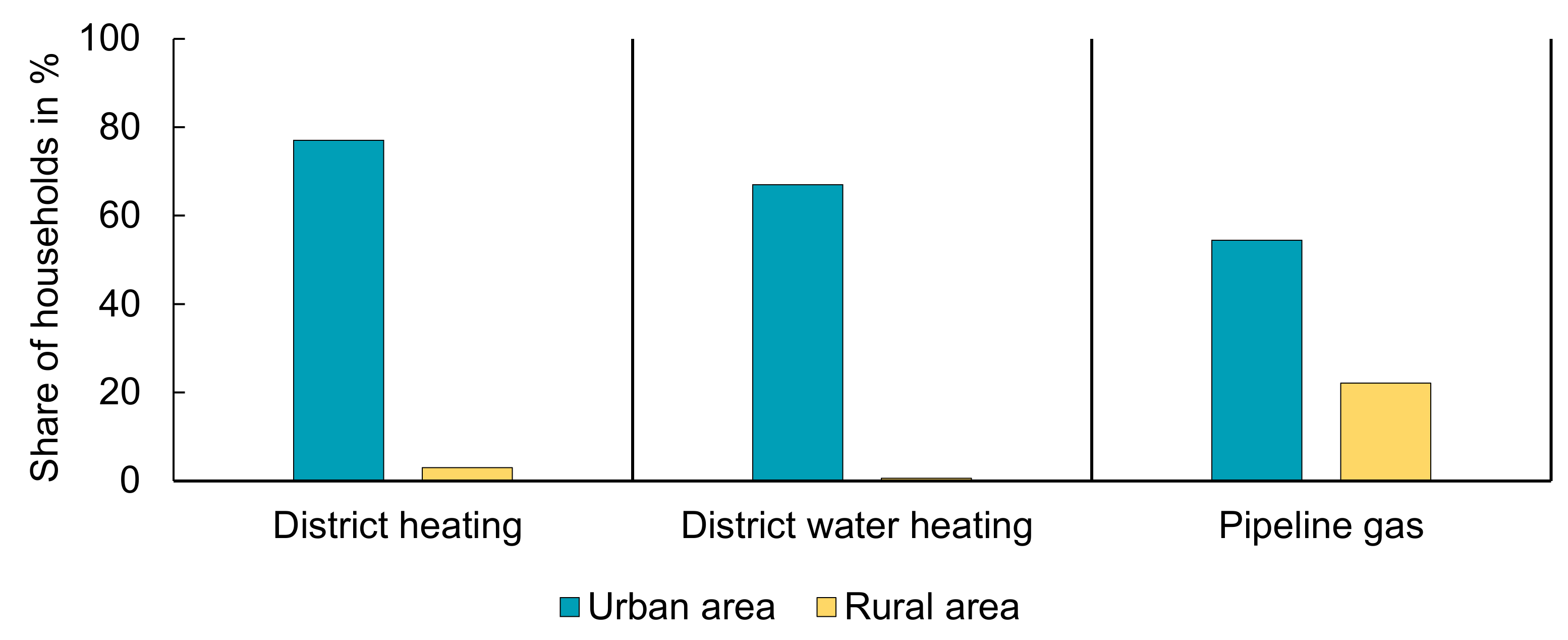
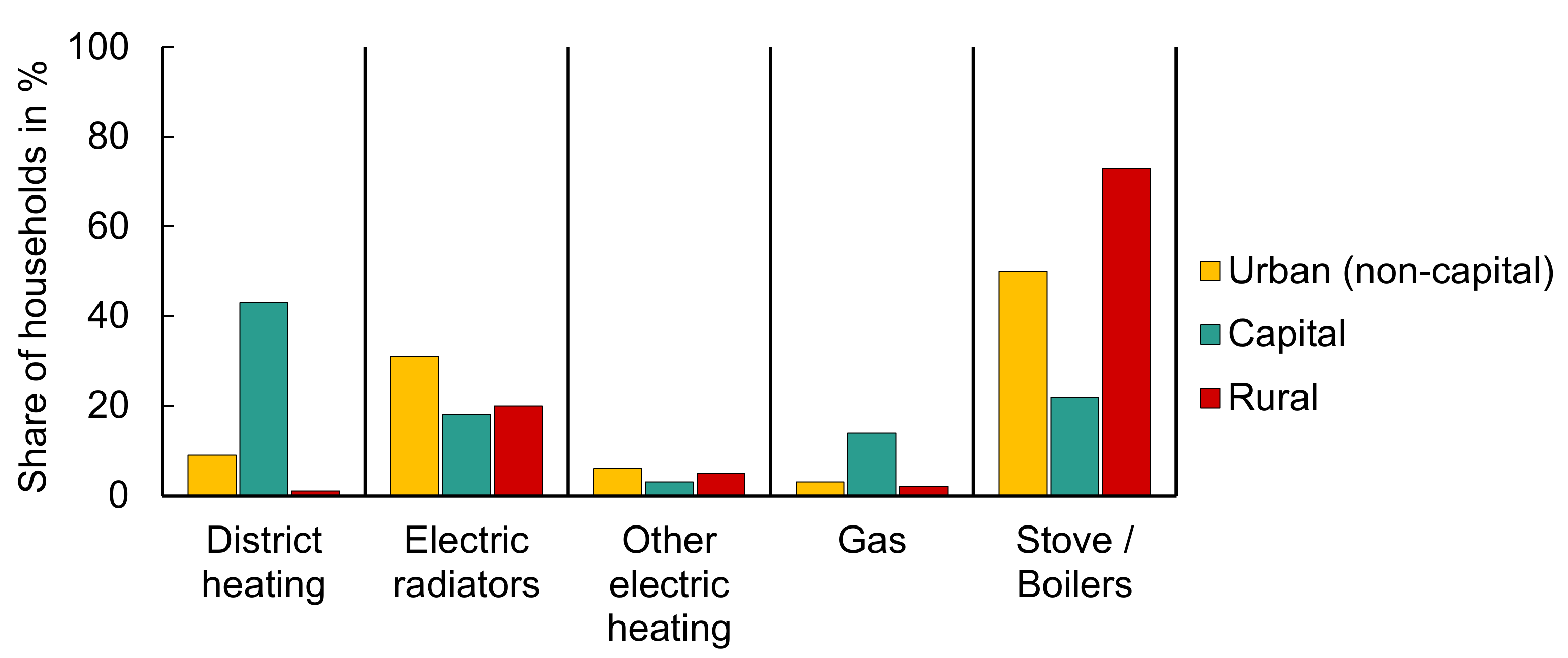
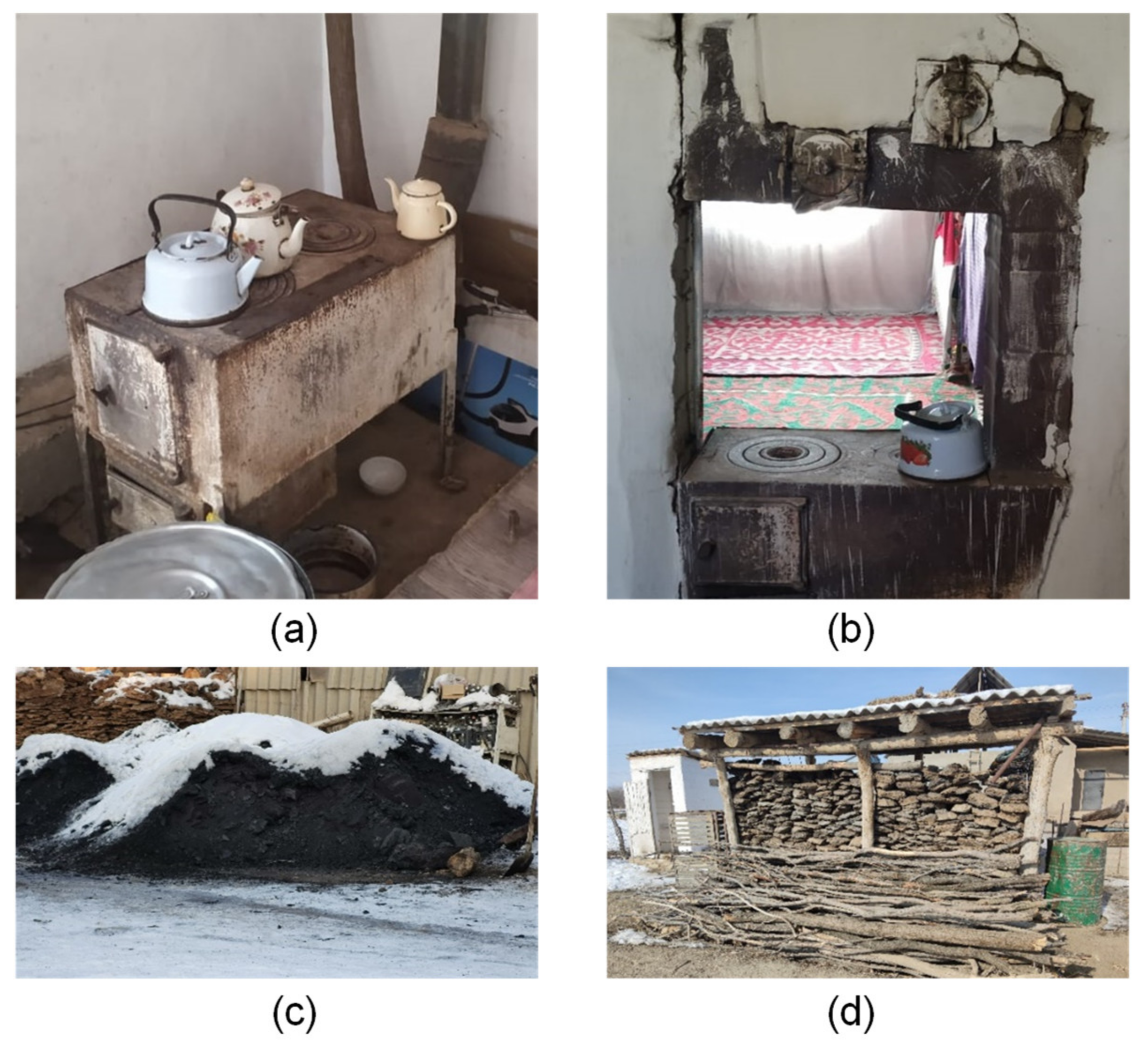
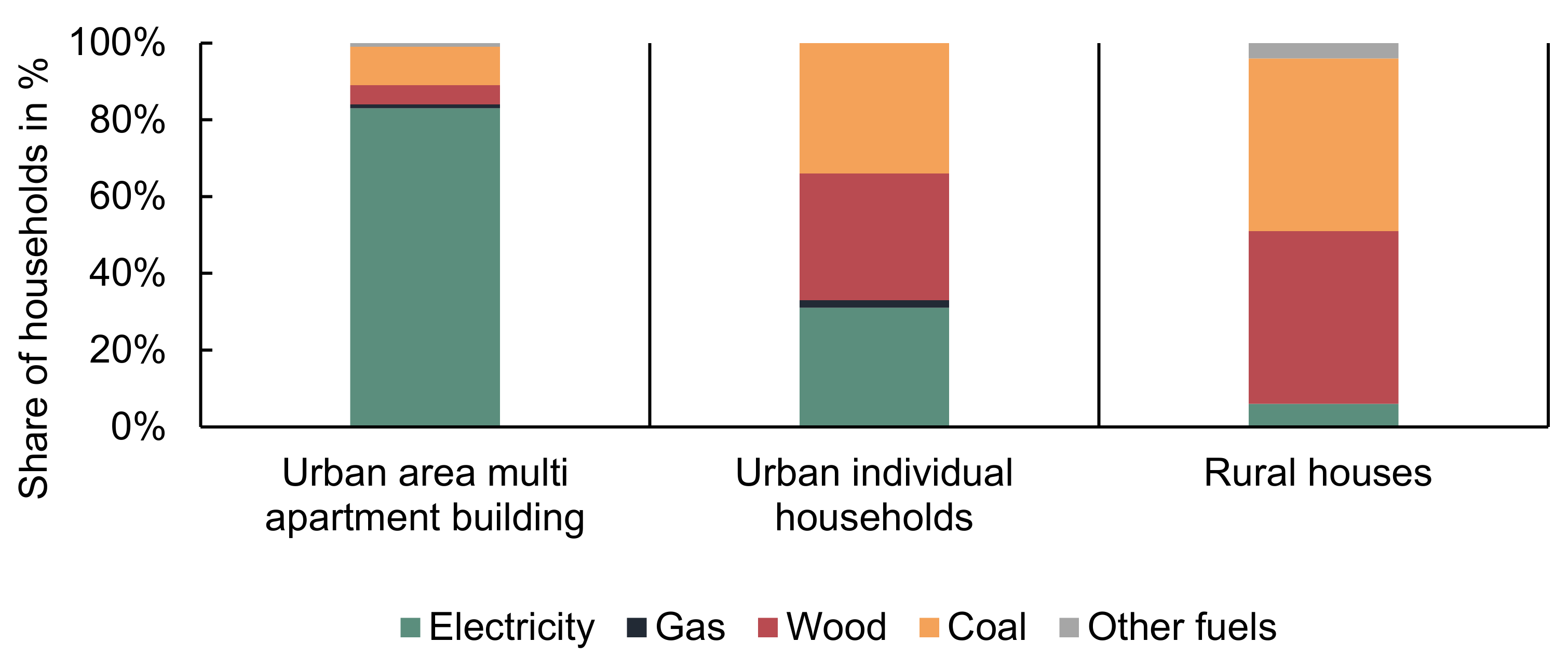
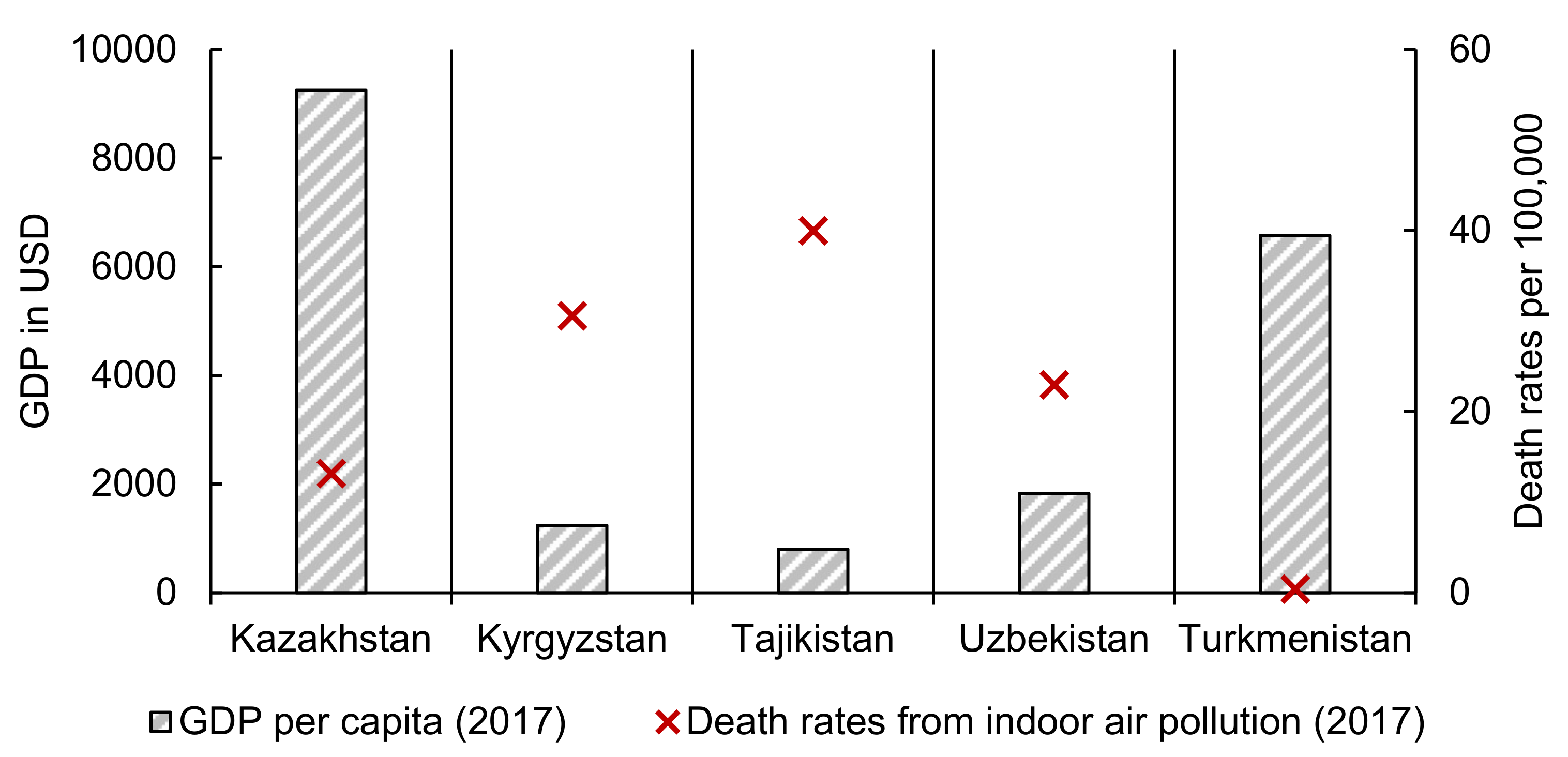
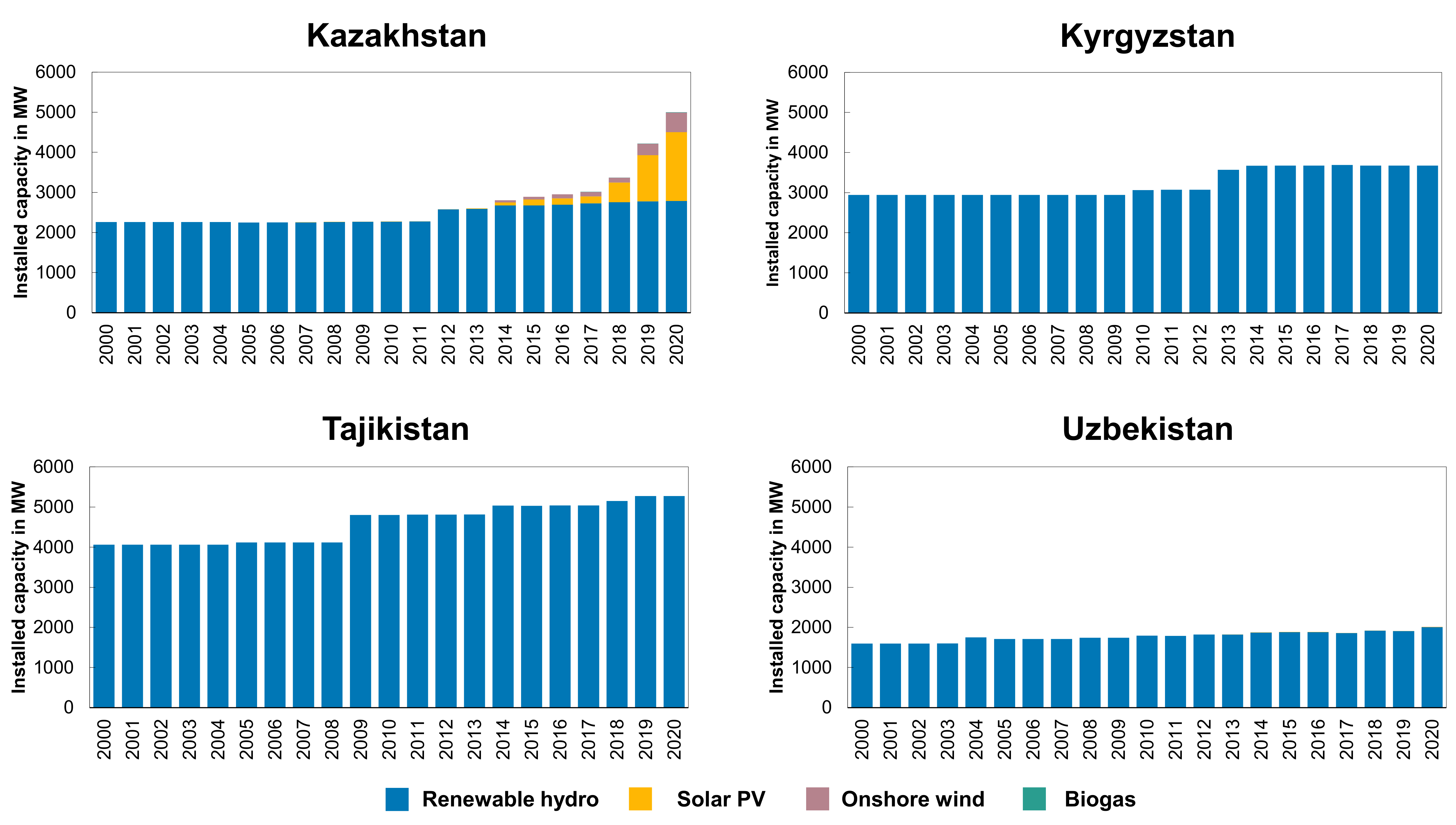
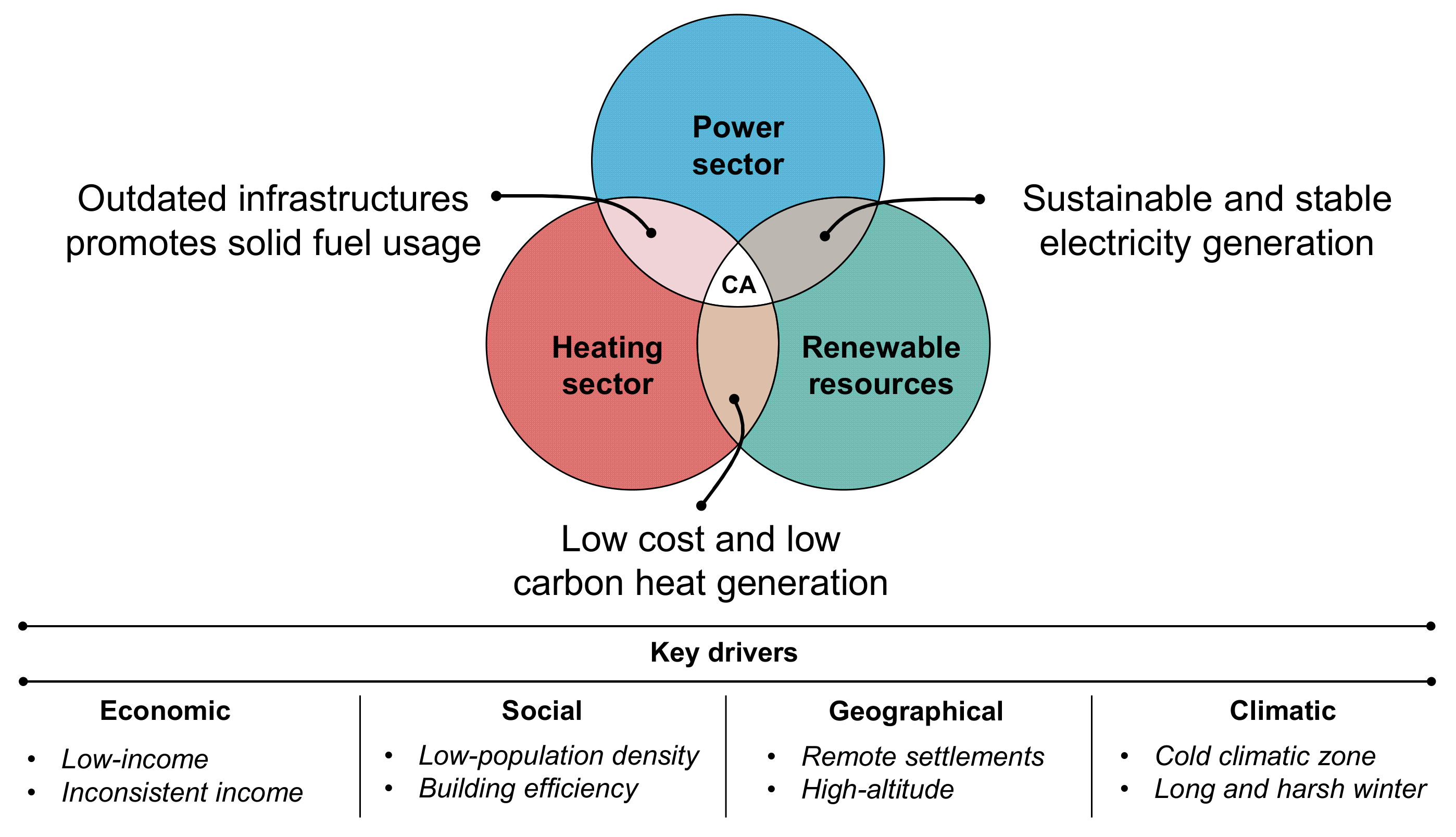
| Indicator | Kazakhstan | Turkmenistan | Uzbekistan | Kyrgyzstan | Tajikistan |
|---|---|---|---|---|---|
| Surface area in km2 | 2,724,902 | 488,100 | 447,400 | 199,950 | 141,380 |
| Population in million | 18.2 | 5.8 | 32.95 | 6.3 | 9.1 |
| Share of rural population in % | 43 | 43 | 50 | 64 | 73 |
| Gross Domestic Product in billion | USD 170 | USD 40.761 | USD 50.49 | USD 8.0 | USD 7.5 |
| Gross National Income/capita | USD 7970 | USD 6380 | USD 2000 | USD 1130 | USD 990 |
| Country | Kazakhstan | Kyrgyzstan | Tajikistan | |
|---|---|---|---|---|
| Energy demand indicators | Typical rural residential house |  | 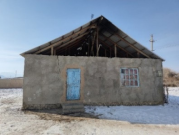 | 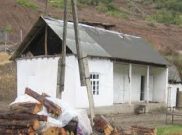 |
| Heating degree days | Over 5000 | 2200 to 4900 | 2000 to 7000 | |
| Range of average heat demand (kWh/m2/year) |  |  |  | |
| Energy supply indicators | Electricity for heating | ∙ Frequent power shortages, as well as massive coal reservoirs, lead people towards traditional heating. | ∙ Because of inadequate power supply and low-income, electric heating is not increasing in rural Kyrgyzstan. | ∙ Low-incomes and an inconstant electricity supply make it unaffordable and unreliable for heating, respectively. |
| District heating | ∙ DH networks operated by coal and natural gas are very common in urban areas. However, rural areas are not connected. | ∙ Only 19% of total Kyrgyz households are connected to very inefficient DH systems which are concentrated in urban areas. | ∙ Only 8% of Tajik households are connected to DH in urban settlements. Major DH systems are not in operation. | |
| Traditional methods | ∙ Coal-operated/fired boiler use for space heating purposes by 70% of the rural population. | ∙ Traditional heating methods involving solid fuels commonly used by rural households (around 73%). | ∙ Traditional heating stoves are the favoured heat supply systems for more than 80% of households. | |
| Heating fuels in heating season | ∙ Coal (5–8 tons), natural gas and electricity (according to financial capacities) | ∙ Coal (2–4 tons), firewood (1–4 m3) and cow-dung (1–2 truckload) | ∙ Coal (1–3 tons), firewood (1–3 tons) and cow-dung (1–2 tons) | |
| Area | Kazakhstan | Kyrgyzstan | Tajikistan |
|---|---|---|---|
| Urban area | 78 | 85 | 93 |
| Rural area | >35 | 58 | 49 |
| Author | Research Title | Research Aim | Key Findings | |
|---|---|---|---|---|
| Central Asia | Shardina (2020) [93] | Non-Hydropower Renewable Energy in Central Asia: Assessment of Deployment Status and Analysis of Underlying Factors | This paper aimed to assess the reasons behind the untapped and limited development of RE sectors in Central Asian countries. | The article summarises that RE sources are distributed unevenly, and the author also suggested policy implications to improve the commitment to RE in Central Asia. |
| Nurdavletova and Akatayeva (2018) [96] | The renewable energy in the regional development of Central Asia | The main objective of the article was to investigate the available alternative sources in Central Asia and inter-regional complexity. | The article provided a glance at the potential of the RE sector in individual countries and key hurdles in detail for the implementation of RE in Central Asian republics. | |
| Abylkasymova (2019) [103] | Wind Power Potential of the Central Asian Countries | Theoretical wind power supply capacity as well as existing wind power installations were investigated as a key aim of the article. | Wind power has significant theoretical potential in all Central Asia countries. Over 70% of regional total wind potential is concentrated in Kazakhstan. | |
| Gubaidullina et al. (2017) [104] | Renewable energy and the regional prospect on sustainable development of Central Asia | The paper aimed to provide useful information on the issues of renewable energy in Central Asia, as well as the insight of RE status for individual countries. | The most rapid development in the field of renewable energy is noticed in Kazakhstan and the least developed sphere of RES is in Turkmenistan. | |
| Kiseleva et al. (2017) [105] | Efficiency estimation for the grid-tie photovoltaic stations construction in some regions of Central Asia and Transcaucasia | This techno-economic assessment evaluated the construction of network PV farm (5 MW) in selected regions of Central Asian countries. | By consideration of local feed-in tariffs, the simple payback period was determined to last 4–6 years in different regions of Central Asia for small scale PV farms (5 MW). | |
| Kazakhstan | Zavadskiy and Revalde (2020) [106] | Problems of development of renewable energy facilities in rural regions on the example of Kazakhstan | This manuscript presents an outline of the difficulties and problems with the development of renewable energy sources in the rural regions of Kazakhstan | Kazakhstan possesses great renewable energy potential, especially in rural areas (solar, wind and bioenergy). The research article also recommends employing a special programme/policy to promote RE in Kazakhstan. |
| Vakhguelt (2017) [107] | Renewable Energy Potential of Kazakhstan | The article presents the recent status quo of available potential of hydropower, wind power, solar power, geothermal energy, and bioenergy and their available operations in Kazakhstan. | Kazakhstan has a great potential for renewable energy production. Most of the Kazakh territory has great solar potential as well as considerable wind energy. | |
| Karatayev et al. (2016) [108] | Renewable energy technology uptake in Kazakhstan: Policy drivers and barriers in a transitional economy | With the help of the analytical hierarchy process, this paper investigates and ranks the different barriers towards the adoption of renewable energy in Kazakhstan. Also, it provides interesting insights into the country’s legal framework. | It was identified that sustainable and affordable RE systems toned to be introduced in Kazakhstan for low carbon energy generation. Despite abundant available RE resources renewable energy currently contributes to less than 1% of the country’s power generation. | |
| Kyrgyzstan | Abidov et al. (2020) [109] | Comparative Analysis of Some Types of Renewable Energy Sources | The article discussed the current state and possibilities of using alternative energy in Kyrgyzstan. It also assessed non-traditional renewable energy sources as well as the economic efficiency and its payback period. | The article identified that each type of RE source has its positive benefits in various regions of Kyrgyzstan. It also explained the reasons behind the insufficient use of RE in Kyrgyzstan. |
| Baybagyshov and Degembaeva (2019) [99] | Analysis of the usage of renewable energy in Kyrgyzstan | The manuscript defined the analysis results of the opportunity of using renewable energies (Solar, wind, hydro, biomass, and geothermal) in Kyrgyzstan. | The analysis showed that the country has a great potential for renewable energy, which is unexploited. The use of renewable energy for Kyrgyzstan should be considered as a solution to population’s socio-economic problems in the decentralised high-altitude regions region. | |
| Tajikistan | Schulz et al. (2014) [110] | The energy supply for mountain settlements in Tajikistan based on renewable energy sources | This article investigated the electrification of mountain settlements/communities of Tajikistan by means of combined forms of renewable energy sources (i.e., a small hybrid hydropower station, small PV station). | The article claimed that there is an immediate need to solve the seasonal deficiency of the Tajik power sector. It suggests that a small-scale hybrid power station operated by combined RE sources will be suitable for sustainable electricity supply for remote settlements in Tajikistan. |
| Doukas et al. (2012) [111] | Promoting renewables in the energy sector of Tajikistan | The document presented multi-dimensional approach to identify the suitability of decentralised heat production in Tajikistan. | Technically, a low-pressure solar water heater is a more suitable design for Tajikistan. Also, the paper identified the hurdles for further development of decentralised heat production. |
Publisher’s Note: MDPI stays neutral with regard to jurisdictional claims in published maps and institutional affiliations. |
© 2021 by the authors. Licensee MDPI, Basel, Switzerland. This article is an open access article distributed under the terms and conditions of the Creative Commons Attribution (CC BY) license (https://creativecommons.org/licenses/by/4.0/).
Share and Cite
Mehta, K.; Ehrenwirth, M.; Trinkl, C.; Zörner, W.; Greenough, R. The Energy Situation in Central Asia: A Comprehensive Energy Review Focusing on Rural Areas. Energies 2021, 14, 2805. https://doi.org/10.3390/en14102805
Mehta K, Ehrenwirth M, Trinkl C, Zörner W, Greenough R. The Energy Situation in Central Asia: A Comprehensive Energy Review Focusing on Rural Areas. Energies. 2021; 14(10):2805. https://doi.org/10.3390/en14102805
Chicago/Turabian StyleMehta, Kedar, Mathias Ehrenwirth, Christoph Trinkl, Wilfried Zörner, and Rick Greenough. 2021. "The Energy Situation in Central Asia: A Comprehensive Energy Review Focusing on Rural Areas" Energies 14, no. 10: 2805. https://doi.org/10.3390/en14102805
APA StyleMehta, K., Ehrenwirth, M., Trinkl, C., Zörner, W., & Greenough, R. (2021). The Energy Situation in Central Asia: A Comprehensive Energy Review Focusing on Rural Areas. Energies, 14(10), 2805. https://doi.org/10.3390/en14102805





